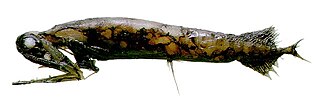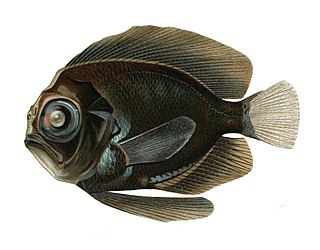
Columbidae is a bird family consisting of doves and pigeons. It is the only family in the order Columbiformes. These are stout-bodied birds with short necks and short slender bills that in some species feature fleshy ceres. They primarily feed on plants, and can be taxonomically divided amongst granivores, that feed mostly on the ground on seeds, and frugivores, that feed mostly on fruits, from branches. The family occurs worldwide, often in close proximity with humans, but the greatest variety is in the Indomalayan and Australasian realms.

Ovenbirds or furnariids are a large family of small suboscine passerine birds found from Mexico and Central to southern South America. They form the family Furnariidae. This is a large family containing around 315 species and 70 genera. The ovenbird, which breeds in North America, is not a furnariid – rather it is a distantly related bird of the wood warbler family, Parulidae.

The genus Arceuthobium, commonly called dwarf mistletoes, is a genus of 26 species of parasitic plants that parasitize members of Pinaceae and Cupressaceae in North America, Central America, Asia, Europe, and Africa. Of the 42 species that have been recognized, 39 and 21 of these are endemic to North America and the United States, respectively. They all have very reduced shoots and leaves with the bulk of the plant living under the host's bark. Recently the number of species within the genus has been reduced to 26 as a result of more detailed genetic analysis.

The Pacific viperfish, is a predatory deep-sea fish found in the North Pacific. It is reported as being either mesopelagic or bathypelagic, with diel vertical migration to shallower waters. The Pacific viperfish is one of the nine different species that belong to the genus Chauliodus, the viperfish. The Pacific viperfish tend to be the largest of the species, typically reaching lengths of up to 1 foot and are considered an example of deep-sea gigantism. The length-weight relationship of the pacific viperfish varies with sex with females tending to be longer and heavier than males.

The footballfish form a family, Himantolophidae, of globose, deep-sea anglerfishes found in tropical and subtropical waters of the Atlantic, Indian, and Pacific Ocean. The family contains 23 species, all of which are classified in a single genus, Himantolophus.

Stomiidae is a family of deep-sea ray-finned fish, including the barbeled dragonfishes. They are quite small, usually around 15 cm, up to 26 cm. These fish are apex predators and have enormous jaws filled with fang-like teeth. They are also able to hinge the neurocranium and upper-jaw system, which leads to the opening of the jaw to more than 100 degrees. This ability allows them to consume extremely large prey, often 50% greater than their standard length.

Malacosteus niger, commonly known as the black dragon fish, is a species of deep-sea fish. Some additional common names for this species include: northern stoplight loosejaw, lightless loosejaw, black loosejaw, and black hinged-head. It belongs to the family Stomiidae, or dragonfishes. It is among the top predators of the open mesopelagic zone. M. niger is a circumglobal species, which means that it inhabits waters ranging from the tropics to the subarctics. Not many studies have been conducted on its feeding habits, but recent research suggests that M. niger primarily feed on calanoid copepods which is a form of zooplankton. Indeed, it appears that M. niger primarily prey on zooplankton despite its apparent morphological adaptations for the consumption of relatively large prey. Another unique adaptation for this species is its ability to produce both red and blue bioluminescence. Most mesopelagic species aren't capable of producing red bioluminescence. This is advantageous because most other species cannot perceive red light, therefore allowing M. niger to camouflage part of itself to its prey and predators.

Tyrannophryne is a monospecific genus of marine ray-finned fish belonging to the family Oneirodidae, the dreamers, a family of deep-sea anglerfishes. The only species in the genus is Tyrannophryne pugnax, the tyrant devil. Like other oneirodids, T. pugnax is a bathypelagic fish with a bioluminescent lure. It is known only from two adolescent female specimens, one caught in 1928 near Tahiti-Rarotonga, and the other in 1956 northwest of Bikini Atoll.
Malacosteus australis, the southern stoplight loosejaw, is a species of barbeled dragonfish. This species is mainly distinguished from Malacosteus niger by a smaller postorbital photophore in both sexes and lower numbers of lateral photophores. It also differs in having somewhat smaller jaws, a fleshy orbit, and several subtle morphological traits. The maximum known length is 253.2 mm. Its specific epithet comes from the Latin austral, meaning "southern". It is known for its red bioluminescence which helps M. australis visualize in the aphotic deep sea.
Aristostomias is a genus of barbeled dragonfishes native to the ocean depths in the Pacific, Atlantic and Indian oceans.
Pachystomias microdon, the smalltooth dragonfish, is a species of barbeled dragonfish found in the oceans at depths of from 660 to 4,000 metres. This species grows to a length of 22.1 centimetres (8.7 in) SL. This species is the only known species in its genus.

Caristius is a genus of manefishes native to the Atlantic and Pacific Oceans.
Neocaristius heemstrai is a species of fish in the family Caristiidae, the manefishes. It is native to the oceans of the southern hemisphere where it is known to occur at depths of from 420 to 1,360 metres. This species grows to a length of 11.8 centimetres (4.6 in) SL.

Platyberyx is a genus of manefishes native to the eastern Atlantic Ocean.
Peter John Herring is an English marine biologist known for his work on the coloration, camouflage and bioluminescence of animals in the deep sea, and for the textbook The Biology of the Deep Ocean.
Cladocolea cupulata is a species of dioecious, parasitic mistletoe in the family Loranthaceae. The natural range of Cladocolea cupulata is throughout parts of Jalisco, Mexico, where it is known to specifically grow on pine trees, such as, Pinus lumholtzii, Pinus herrerae, Pinus douglasiana, Pinus jaliscana, and Pinus georginae.
Photostomias atrox is a species of barbeled dragonfish in the genus Photostomias. The species has been documented in the Atlantic and Pacific oceans, and fully-grown members of the species can reach a maximum length of ~15.4 centimeters.

Photostomias goodyeari is a species of barbeled dragonfish in the genus Photostomias. The species has been observed in the Atlantic Ocean, specifically in the Gulf of Mexico, and fully-grown members of the species can reach a maximum of ~17.5 centimeters in length.
Photostomias guernei is a species of barbeled dragonfish in the genus Photostomias. The species has been documented in the Atlantic and Pacific oceans, and fully-grown members of the species can reach a maximum length of ~16 centimeters.
Photostomias tantillux is a species of barbeled dragonfish in the genus Photostomias. The species has been documented in the Pacific Ocean off the coast of Japan, and fully-grown members of the species can reach a maximum length of ~10.1 centimeters.













